|
Deep in the Central
and South American jungles are several small monkeys collectively
referred to as the Tamarin Monkeys. They live nearly their
entire lives in trees, minus the ones which are kept as house
pets, obviously. When the majority of biologists speak of
Tamarins, they undoubtedly are speaking of these primates.
When marine biologists speak of Tamarins, however, they are
not concerning themselves with the fur-ball with a whip-like
tail. Instead, they are discussing a genus of marine fish.
What is the connection between the monkeys and these fish?
Nothing more than a coincidence, it seems. The genus Anampses
was more likely given its unusual common name after the Tamarin
Bay located in Mauritius. I will leave the discussion of the
monkeys for another day and instead focus upon the Tamarin
wrasses for the August edition of Fish Tales.
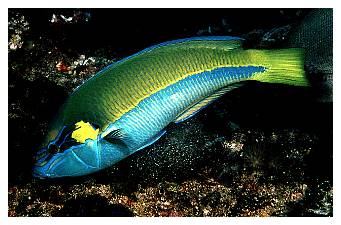 |
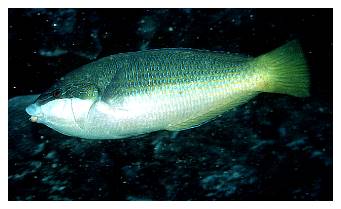 |
|
The Elegant wrasse, Anampses elegans, is certainly
more colorful as a male (top) than as a female
(bottom). Juveniles are nearly completely green.
Their limited geographical distribution likely eliminates
any chance of seeing these in home aquariums with any
regularity. Photos courtesy of John Randall.
|
Meet the Family
Labridae is the
second largest marine fish family and contains 60 genera,
one of which is Anampses. Anampses is further
divided into two subgenera: Psuedoanampses and Anampses.
Thirteen species are included in the genus (see below). All
Anampses, must possess set of morphological features
which includes "a single pair of broad, projecting incisiform
teeth at the front of the jaws, scaleless head, smooth preopercular
margin, and complete lateral line" (Randall, 1972). The
subgenera differ in the number of lateral line scales. Psuedoanampses
will have 48-50 scales while Anampses have only 26-27.
One species, A. melanurus, was further divided into
two subspecies. Known only from the Red Sea, A. melanurus
lineatus is colored slightly differently than the wider-ranging
A. melanurus melanurus. As its name suggests, lines
or dashes are present on A. melanurus lineatus, whereas
the marks are present only as spots or dots on A. melanurus
melanurus.
|
Labridae
- Anampses
- Anampses
- caeruleopunctatus
- chrysocephalus
- cuvier
- elegans
- femininus
- lennardi
- lineatus
- melanurus
- meleagrides
- neoguinaicus
- twistii
- viridis
- Pseudoanampses
|
|
Like so many of the Labrids, Anampses has been a confounding
genus for ichthyologists to organize. Most species in the
genus have up to three distinct color variations which at
one time caused ichthyologists to consider that the genus
contained up to 32 species (Randall, 1972). Careful study
and documentation, mostly by observing natural behavior in
the wild, has resulted in the trimmed down list seen above.
The genus was introduced to the scientific community by Quoy
and Gaimard (1824) with the description of Anampses cuvier.
By 1839, seven more species had been assigned to the genus
Anampses. Ruppell (1828) was responsible for naming
A. caeruleopunctatus and then A. diadematus
(Ruppell, 1835). As an example of the confusion that the color
patterns in the genus amy caused, this latter species was
later determined to be a male of previously described A.
caeruleopunctatus (Randall, 1972). Bleeker identified
five additional species during a period of 22 years, but only
two are now recognized as valid: A. twistii and A.
melanurus. Additionally, it was Bleeker (1862) who first
recognized that A. geographicus warranted separate
classification by offering Pseudoanampses as a possible
generic name; however, he still retained the name Anampses
for this particular specimen. This is key, because despite
the overabundance of named species, every author correctly
placed each species into its correct genus - something of
a rarity in ichthyology, considering the confusion that existed
within genus.
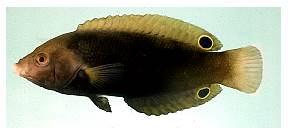 |
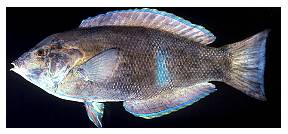 |
|
The olive green coloration of the juvenile Anampses
geographicus (left) is indicative of the
shallow, often algae covered territory it prefers. At
7 - 8 inches they will become functional males (right).
Photos courtesy of John Randall.
|
Throughout the early- to mid-1900's authors attempted to
align the species into synonymy. Although the vast majority
of these attempts were in error, nine connections proved to
be correct. Ironically, none of the correct synonyms was of
different sexual forms. At this time sexual dimorphism was
not a factor to be considered since it was not understood.
This is because fish species were, and are, described primarily
from preserved specimens, and colors are lost in preservation
as most of the proteins that they are based on are denatured.
Virtually all preserved fishes are white, yellow or grey,
the colors of most tissues in formaldehyde solutions. Finally,
Randall (1958) offered just such a theory when he placed Anampses
pterophthalmus into synonymy with A. geographicus,
which was shortly followed by Whitley (1964) proclaiming,
"due to variations in colour with growth or sex in these
fishes, it is probable that the number of species may be drastically
reduced." And so it was with the release of Randall's
findings (1972).
In the Wild
The vast clear-blue
seas of the tropical Indo-Pacific house all species of Anampses.
Anampses caeruleopunctatus is the most widespread of
all species, and its vast distribution seems to be an anomaly
among members of this genus. Unlike many Red Sea natives,
which rarely have a geographical range outside of the Red
Sea, A. caeruleopunctatus remains plentiful on most
extensive reef systems extending from the Africa's east coast
all the way to Easter Island, although it has yet to be sighted
around the Hawaiian Islands. Instead, its very close cousin,
A. cuvier, is found around the big island. Ironically,
A. cuvier remains endemic to only the Hawaiian Islands,
and thus shares the most limited geographic distribution in
the family with A. chrysocephalus, which also is endemic
to the Hawaiian Islands. In fact, A. chrysocephalus is
known only from the Kona coast of Hawaii and Oahu. Geographic
limitation is not restricted to the above species, however,
as A. neoguinaicus is rarely found outside Fijian waters
(even though the original description came from a specimen
captured in New Guinea) and A. melanurus lineatus has
not been found outside the northern reaches of the Red Sea.
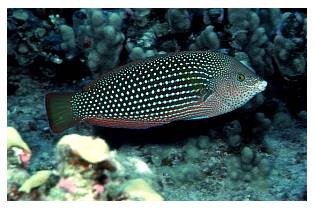 |
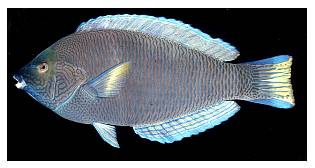 |
|
A male Anampses cuvier (bottom), even
at 10 inches of length, rarely consumes food items in
the wild over 4 mm in size. In my opinion, however,
the female (top) is more desirable due to their
magnificent beauty and smaller size. Photos courtesy
of John Randall.
|
Tamarin wrasses associate directly with
reefs for a number of reasons. These often small and delicate
wrasses rely on the rock structure for protection from larger
predators. Hiding within the rockwork is often their first
attempt at eluding a predator, but their best defense is undoubtedly
their unusual ability to bury themselves into the sandbed.
In addition to protecting them from predation, the sand becomes
their bed as the sun begins to fall.
The rock structure also holds the key to the Tamarin wrasses'
diet. Small crustaceans are readily plucked from the rocks
and crushed in their powerful jaws. In a gut analysis of A.
cuvier, the majority of the captured prey consisted of
small shrimps and amphipods, but copepods, isopods and brachyuran
crabs were commonly found as well. Additionally, a few fish
contained large enough quantities of polychaetes to warrant
special mention (Randall, 1972). The Tamarin's broad projecting
incisiform teeth aid in the capture of these small food items
while the pharyngeal plates do a fine job of crushing their
captured prey's shell.
|
Anampses lennardi
retains much the same color characteristics as it ages
from female to male. Lennard’s Tamarin is endemic
to western Australia and thus does not appear in the
American market with any regularity. Photo courtesy
of John Randall.
|
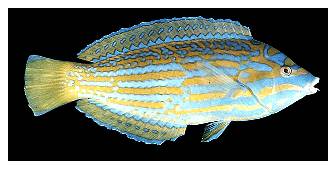 |
Most of the species are not easily located in shallow depths
- if they can be located in there at all. The best spot to
find a member of the genus is generally at depths ranging
from 50 - 100 feet. However, Anampses cuvier has been
captured in a mere six feet of water and thereby represents
the genus' shallowest occurring species. Juvenile members
of A. femininus have been seen in waters as shallow
as 20 feet, but adults can be found only below 50 feet and
become common at depths approaching 75 - 80 feet. Another
species with the same tendency is A. chrysocephalus,
whose juveniles are found at depths of 35 feet and adults
typically move deeper to depths of 65 - 75 feet.
Generally, these fishes form aggregations
of one dominant male and several (or more) females, and spend
the better part of their day feeding upon the reef. The males
are always larger and usually more colorful than the females,
and will flash or display more vibrant colors during courtship.
In all Anampses species the male is a different color
from the female. This two-phase coloration is called "dichromatism."
In some cases coloration varies between juvenile and sexually
mature females, thereby affording three separate color variations
in the same species.
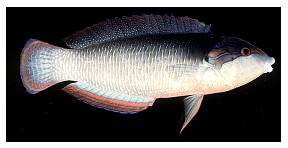 |
Although collected only in limited locations, it is
expected that Anampses neoguinaicus is present
on other Pacific Islands such as Solomon and New Hebrides.
Although juveniles (bottom) are solitary fish,
adults tend to prefer loose aggregations. Photos courtesy
of John Randall.
|
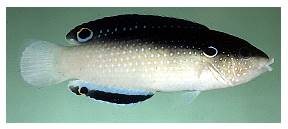 |
No small males have been found, and thus it is presumed that
every male Anampses spp. is a "secondary male,"
that is, a male resulting from a female that has undergone
a sex change, also known as a "protogynous hermaphrodite"
(Randall & Kuiter, 1989). The largest and most dominant
females will change into males when the social order dictates
the need for a male. The death or capture of the previous
male is a sure-fire way to induce the most dominant female
to transform into the newest male on the block.
In the Home Aquarium
Successfully maintaining
a Tamarin wrasse requires a bit more skill than does the average
aquarium fish. Water conditions must be optimal and food options
plentiful, but perhaps the biggest obstacle to overcome is
obtaining a healthy and happy Tamarin. These beautiful wrasses
are often poor shippers and generally arrive at our local
fish stores' aquariums in a less than acceptable condition.
Therefore, careful inspection of the wrasse is the first and
most important step toward long-term success with this genus.
The most obvious sign of a stressful shipment would be damage
around the mouth. As these fish prefer to bury themselves
during stressful situations, it is not uncommon for the mouth
to be scraped, bloodied or even dislocated upon arrival. No
doubt, such specimens should be avoided. Assuming the fish
passes the mouth inspection, the logical next step is to continue
inspecting down the length of the fish, ensuring all its parts
remain fully intact. The fish should also be alert and swimming
with purpose. Finally, if the fish is consuming prepared foods
while still in the retailer's aquarium, it is a good bet this
particular specimen survived the shipping trauma with minimal
injury.
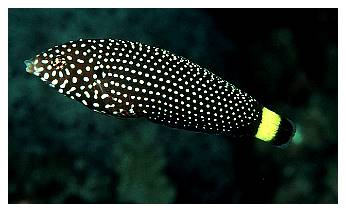 |
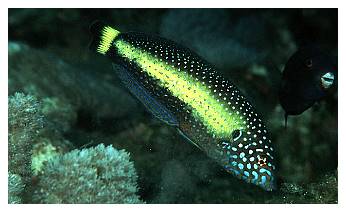 |
|
Anampses melanurus is a popular aquarium inhabitant
due to the magnificent coloration of both the female
(left) and the male (right). The relatively
small size of adult males at 4 inches is a bonus for
aquarists without enormous aquariums as well. Photos
courtesy of John Randall.
|
Although it is always wise to quarantine
every new purchase prior to its final addition to the show
aquarium, this particular step is especially important with
specimens of Anampses. The fish in this genus remain
predominantly shy upon introduction into a home aquarium,
and having to concern itself with fellow tankmates often delays
or permanently corrupts attempts at acclimation. Once the
fish is eating well, astute observation of the stomach should
be made. If the fish is eating well and still appears not
to be retaining its weight, medicated foods should be employed.
An estimated 75 - 85% of imported marine fish have intestinal
worms (Bassleer, 1996), and their natural diet, which consists
of eating mobile invertebrates inhabiting the substrate and
rockwork, often increases the odds that the fish will obtain
a parasitic worm. The stress induced by poor shipping practices
exacerbates this ailment, likely leading to the animal's death.
Normal signs indicating internal worm infestations are: weight
loss despite a healthy appetite, scraping or flashing against
rockwork or sand, and finally, a complete loss of appetite
occurring just prior to death. Treatment for internal worms
can be administered only to a fish that is eating. Live foods
are the best option for medicinal use, as they allow "gut
loading," which is the practice of feeding vitamins or
medicines directly to live foods just prior to feeding. If
live foods are unavailable, the next best option is to use
freeze-dried foods. The dry food will absorb and retain a
majority of the medicine. Piperazine is a good first choice
for treatment. Add 250mg per 100g of food each day for a period
of 10 days. Praziquantel or lecamisole can be used as a second
choice, with the same dosage and time frame. Niclosamide can
also be used at 500mg per 100g of food for 10 days (Bassleer,
1996).
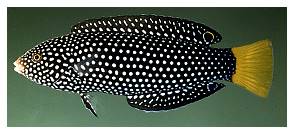 |
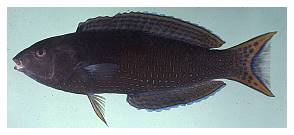 |
|
A female Anampses meleagrides (left) could
easily be confused with A. melanurus, but the
adult male (right) is twice as large and looks
nothing like either its cousin or female conspecific.
However, the male Speckled Tamarin could be confused
with the male A. geographicus quite easily.
Photos courtesy of John Randall.
|
When the time comes to add the new acquisition
to the show aquarium, several factors inside the featured
tank must be met to provide for optimum care. A plethora of
productive rockwork should be in place. By "productive"
I mean capable of producing enough micro-fauna to supplement
the prepared food diet. Anampses species continually
hunt for food and live, natural supplements should be considered
a quintessential part of their healthy diet. In addition to
the foods produced by a well-aged aquarium, the hobbyist should
expect to feed enriched brine shrimp or even gut-loaded live
brine, thawed Mysis species shrimp and flake or pellet
foods geared toward a carnivore's diet. Feedings at least
twice daily should be implemented in reef aquariums producing
a copious amount of natural foods; more frequent feedings
are required in aquariums that do not have an ample supply
of micro-fauna.
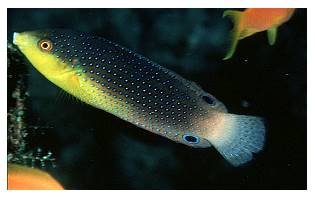 |
Quite a rarity for the Anampses genus, A.
twistii does not exhibit any significant color changes
based on its sex or age. Photo courtesy of John Randall.
|
The rockwork is also important for providing comfort and
security by offering a large selection of secluded hiding
spots. This is especially important upon first introduction,
as the fish will be weary and looking to protect itself. A
thick covering of sand is also a required décor. A
minimum of 2"of sand, preferably more, should be present,
which will allow the fish to dive into it and sleep for the
night. Without the sand the fish will likely injure itself
as it tries to bed down. Speaking of sleeping, you can expect
your Tamarin to go to sleep, and wake up, at nearly the same
time each day. Their internal clock is amazingly predictable.
At first, this might be a problem, as they are still functioning
on Indo-Pacific time. As the days and weeks pass, however,
the fish will slowly readjust their schedule to more closely
resemble the tank's photoperiod.
Mixing multiple Tamarin wrasses in the same aquarium can
result in a stunning display of a male/female pair. Due to
their dimorphic life cycle it is possible for three individuals
of the same species to look completely different from one
another. One caution should be exercised: do not add two males
into the same aquarium. A single Tamarin can be housed in
a standard 75-gallon aquarium provided all tankmates are peaceful
community fish. Mixing multiple Tamarins seems best served
by aquariums six feet in length or larger, thereby giving
each individual some extra swimming room.
Mixing Anampses species with other fish can be done
quite successfully, provided all tankmates are peaceful. Generally
speaking, Tamarins can sometimes act oblivious to the fish
around them, provided they are not interfered with. Small
gobies, cardinals, wormfish and other shy aquarium fish are
well-suited to aquariums whose largest show fish is a Tamarin.
If the Tamarin is not the feature fish and large or active
fish are featured, such as large angels or surgeonfish, expect
the wrasse to be not nearly as outgoing. Tamarins will not
fight for tank space and therefore can easily get pushed around
and take up real estate in hidden corners of the aquarium.
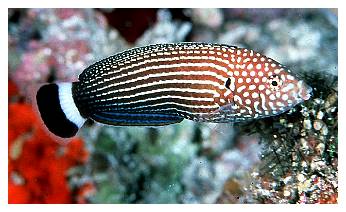 |
All age color stages of Anampses
lineatus are wonderfully amazing and attractive
aquarium inhabitants. Obtaining a juvenile (below)
would be ideal, thereby giving the hobbyist a chance
to view its maturation into an adult female (top).
The male's coloration, not pictured, changes from the
black of the female into a redish hue. Photos courtesy
of John Randall.
|
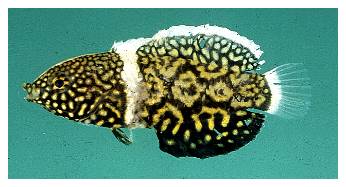 |
Compatibility
chart for Anampses species:
| Fish |
Will
Co-Exist
|
May
Co-Exist
|
Will
Not Co-Exist
|
Notes |
| Angels,
Dwarf |
X
|
|
|
Excellent
choice. |
| Angels,
Large |
|
X
|
|
Some
angels may be too active or aggressive. |
| Anthias |
X
|
|
|
Excellent
choice. |
| Assessors |
X
|
|
|
Excellent
choice; add the assessor first. |
| Basses |
X
|
|
|
Excellent
choice. |
| Batfish |
X
|
|
|
Excellent
choice. |
| Blennies |
X
|
|
|
Excellent
choice. |
| Boxfishes |
X
|
|
|
Excellent
choice. |
| Butterflies |
X
|
|
|
Excellent
choice. |
| Cardinals |
X
|
|
|
Excellent
choice. |
| Catfish |
|
X
|
|
Catfish
grow increasingly aggressive as they grow larger. |
| Comet |
X
|
|
|
Excellent
choice. |
| Cowfish |
X
|
|
|
Excellent
choice. |
| Damsels |
|
X
|
|
Some
damsels are too aggressive for Tamarins. |
| Dottybacks |
|
X
|
|
Some
of the larger dottybacks may choose to harass Tamarins.
|
| Dragonets |
|
X
|
|
Should
be mixed only in large aquariums that can supply natural
foods to both species. |
| Drums |
X
|
|
|
Excellent
choice. |
| Eels |
|
X
|
|
Some
eels may consume Tamarins. |
| Filefish |
X
|
|
|
Excellent
choice. |
| Frogfish |
|
|
X
|
Frogfish
are capable of consuming juvenile Tamarins. |
| Goatfish |
X
|
|
|
Excellent
choice. |
| Gobies |
X
|
|
|
Excellent
choice. |
| Grammas |
X
|
|
|
Excellent
choice. |
| Groupers |
|
|
X
|
Groupers
will become increasingly aggressive and be able to consume
Tamarins as they age. |
| Hamlets |
X
|
|
|
Excellent
choice. |
| Hawkfish |
|
X
|
|
Some
hawkfish may attack Tamarins. |
| Jawfish |
X
|
|
|
Excellent
choice. |
| Lionfish |
|
X
|
|
Some
lionfish grow too large and may consume smaller Tamarins.
|
| Parrotfish |
|
X
|
|
Often
too large and active to share a tank with Tamarins. |
| Pineapple
Fish |
X
|
|
|
Excellent
choice. |
| Pipefish |
|
|
X
|
Pipefish
are best suited for a species designated aquarium. |
| Puffers |
|
|
X
|
Best
avoided. |
| Rabbitfish |
X
|
|
|
Excellent
choice. |
| Sand
Perches |
|
X
|
|
Sand
perches can be aggressive, especially as they grow larger.
|
| Scorpionfish |
|
|
X
|
Scorpionfish
are best left to species tanks. |
| Seahorses |
|
|
X
|
Seahorses
are best suited for a species designated aquarium. |
| Snappers |
|
|
X
|
Aggressive
feeder; will intimidate Tamarins. |
| Soapfishes |
|
|
X
|
Best
avoided. |
| Soldierfish |
|
X
|
|
Should
do well except for the occasional bully. |
| Spinecheeks |
X
|
|
|
Excellent
choice. |
| Squirrelfish |
|
X
|
|
Should
do well except for the occasional bully. |
| Surgeonfish |
X
|
|
|
Excellent
choice. |
| Sweetlips |
|
X
|
|
Some
sweetlips get huge, a potential problem for the Tamarins.
|
| Tilefish |
|
X
|
|
Some
tilefish can behave aggressively. |
| Toadfish |
|
|
X
|
Toadfish
may attempt to consume Tamarins. |
| Triggerfish |
|
|
X
|
Most
triggerfish are too aggressive for Tamarins. |
| Waspfish |
|
X
|
|
Waspfish
may harass juvenile Tamarins. |
| Wrasses |
|
X
|
|
Some
wrasses will co-exist, while others will not. |
Note: While many of the fish listed
are good tankmates for Anampses
species, you should research each fish individually before
adding it to your aquarium. Some of the mentioned fish are
better left in the ocean or for advanced aquarists.
|
This beauty was named Anampses femininus because
the female coloration (left) is more colorful
than the male (right). Also commonly called the
Blue-tail wrasse, no doubt based on the female's coloration,
these are highly sought after aquarium fish. Since juveniles
prefer shallow water and remain in small aggregations,
they can at times be an easy capture. They often move
from shallow inshore reefs to outer reefs at depths
of 100 feet. Photos courtesy of John Randall.
|
Sessile invertebrates are not at risk of
harm from Tamarin wrasses. These wrasses have no desire or
nutritional reason to consider prized corals as food. When
it appears they are harassing corals, they are more likely
chasing down a small hard-shelled mobile invertebrate which
has taken up residence within the coral, rather than harassing
the coral itself. Motile invertebrates, however, are another
story. Generally speaking, larger decorative invertebrates
such as Lysmata species shrimp, starfish and cucumbers
will not be harmed, but small ornamental shrimp are likely
to represent too great a temptation for the wrasse to resist.
Additionally, hermit crabs, Peppermint snails and Stomatella
species snails may begin to disappear at alarming rates.
Obviously, small hard-shelled invertebrates such as the various
copepods and amphipods found in aquariums will be vigorously
hunted. Tamarin wrasses are excellent predators; it is what
they spend their entire afternoon doing.
Meet the Species
Due to the limited
geographic distribution of a number of this genus' species,
very few species are well represented in the aquarium trade.
Those species that do find themselves the target of collector's
nets are undoubtedly the most geographically widespread members,
or ones that are located in key collecting areas.
One of the most popular wrasses in the
genus Anampses is A. chrysocephalus, the Red-Tailed
Tamarin. Unfortunately, the demand for this fish often outweighs
its availability as it is considered limited even in its native
Hawaiian waters. The female color variety is exceptionally
beautiful, and thus is the most commonly imported color phase
of this species. Given their potential adult size of six inches
and their preference for being paired with an adult of the
opposite gender, these wrasses can make for a wonderful display
in a peaceful reef aquarium.
|
The male's coloration (right) is likely the cause
for the common name given to Anampses chrysocephalus
- the Psychedelic Tamarin. Even still, the female coloration
(left) of this Hawaiian endemic is remarkable
itself.
Photos courtesy of John Randall.
|
The Blue-striped Tamarin is desirable merely
because its females' coloration is so attractive. In fact,
the female is so wonderfully attractive that it was named
Anampses femininus. Unfortunately for all hobbyists,
when this fish becomes available it is more often collected
as a mistake than actually being purposefully sought. These
fish are rather shy and reclusive, especially once divers
with nets make their presence felt on the wild reef. As such,
expect a very expensive price tag to be associated with them.
Even so, if you can track down a few members of this species,
an interesting and presumably rare captive harem can be observed.
Anampses meleagrides is perhaps
this genus' most often purchased member. Its vast geographic
diversity no doubt increases its overall availability. Thankfully,
its coloration is every bit as eclectic as the other Anampses
species and thus it remains quite an attraction to observers
and collectors alike. It can reach sizes up to nine or 10
inches; therefore, a larger aquarium may be needed when compared
to the smaller members of this genus.
Conclusion
Aquarists looking
to add an exquisitely colored fish to a community reef aquarium
should consider the Tamarin wrasses. Although their feeding
can sometimes be picky and often detrimental to keeping Dragonette
species, they do possess several characteristics which make
them an inviting inhabitant of most reef aquaria. Their generally
small size makes them ideal for most reef aquariums, while
their peaceful disposition lends ease to mixing them with
other small, peaceful community fish. With a few precautions
considered and dealt with prior to their purchase, hobbyists
can reward themselves with a stunning addition to their tank.
|

